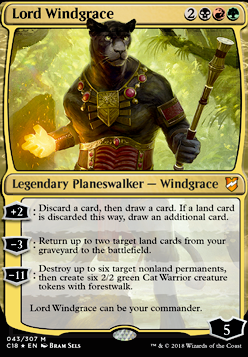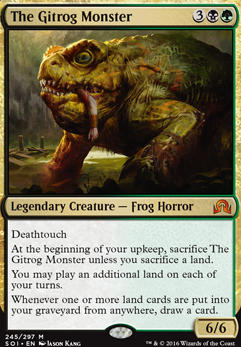
[Primer] The Windfall Crucible: A Gitrog Tale
Commander / EDH BRG (Jund) Land Destruction Landfall Lands Tokens
Land (42)
- 1x Barren Moor
-
1x
Blood Crypt

- 1x Bloodstained Mire
- 1x Bojuka Bog
- 1x Boseiju, Who Endures
- 1x Canyon Slough
- 1x Command Tower
- 1x Evolving Wilds
- 1x Field of the Dead
- 4x Forest
- 1x Forgotten Cave
- 1x Khalni Garden
- 3x Mountain
- 1x Mountain Valley
-
1x
Overgrown Tomb

- 1x Petrified Field
- 1x Prismatic Vista
- 1x Rocky Tar Pit
- 1x Savage Lands
- 1x Sheltered Thicket
- 2x Snow-Covered Forest
- 1x Snow-Covered Mountain
- 1x Snow-Covered Swamp
-
1x
Stomping Ground

- 1x Strip Mine
- 2x Swamp
- 1x Terramorphic Expanse
- 1x Tranquil Thicket
- 1x Urborg, Tomb of Yawgmoth
- 1x Verdant Catacombs
- 1x Volrath's Stronghold
- 1x Wasteland
- 1x Wooded Foothills
- 1x Yavimaya, Cradle of Growth
- 1x Ziatora's Proving Ground
Creature (28)
- 1x Akoum Hellkite
- 1x Ancient Greenwarden
- 1x Avenger of Zendikar
- 1x Azusa, Lost but Seeking
- 1x Budoka Gardener Flip
- 1x Caustic Crawler
- 1x Dread Presence
- 1x Dryad of the Ilysian Grove
-
1x
Lotus Cobra

- 1x Mina and Denn, Wildborn
- 1x Multani, Yavimaya's Avatar
- 1x Nesting Dragon
- 1x Nylea, God of the Hunt
- 1x Ob Nixilis, the Fallen
- 1x Omnath, Locus of Rage
- 1x Oracle of Mul Daya
- 1x Oran-Rief Hydra
-
1x
Phylath, World Sculptor

- 1x Rampaging Baloths
- 1x Ramunap Excavator
-
1x
Scute Swarm

- 1x Sylvan Safekeeper
- 1x The Gitrog Monster
-
1x
Titania, Protector of Argoth

- 1x Turntimber Sower
- 1x Undergrowth Champion
- 1x Vexing Shusher
- 1x Wayward Swordtooth
Planeswalker (4)
Artifact (4)
Commander (1)
Sorcery (8)
-
1x
Cultivate

- 1x Demonic Tutor
- 1x Exsanguinate
- 1x Grim Tutor
- 1x Lavalanche
- 1x Life from the Loam
- 1x Scapeshift
- 1x Torment of Hailfire
Instant (7)
- 1x Chord of Calling
- 1x Crop Rotation
- 1x Harrow
- 1x Heroic Intervention
- 1x Realms Uncharted
- 1x Windgrace's Judgment
- 1x Worldly Tutor
Enchantment (6)
Maybeboard
Creature (8)
Land (1)
Instant (1)
Sorcery (1)
Artifact (1)
Suggestions
Updates Add
Comments
Attention! Complete Comment Tutorial! This annoying message will go away once you do!
Important! Formatting tips — Comment Tutorial — markdown syntax
Please login to comment
92% Casual
Competitive
| Top Ranked |
|
| Date added | 6 years |
| Last updated | 1 year |
| Exclude colors | WU |
| Legality | This deck is Commander / EDH legal. |
| Rarity (main - side) | 19 - 0 Mythic Rares 46 - 0 Rares 14 - 0 Uncommons 8 - 0 Commons |
| Cards | 100 |
| Avg. CMC | 3.45 |
| Tokens | Beast 4/4 G, Cat Warrior 2/2 G, City's Blessing, Copy Clone, Dragon 2/2 R, Dragon Egg 0/2 R, Elemental 5/3 G, Elemental 5/5 RG, Elemental X/X G, Emblem Nissa, Vital Force, Emblem Wrenn and Seven, Emblem Wrenn and Six, Insect 1/1 G, Plant 0/1 G, Treefolk */* G w/ Reach, Zombie 2/2 B |
| Folders | cards i may want to buy in the future, inpsiration, Inspiration, New Possibilities |
| Votes | |
| Ignored suggestions | |
| Shared with | |
| Views |



